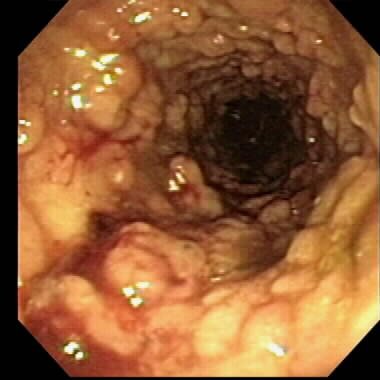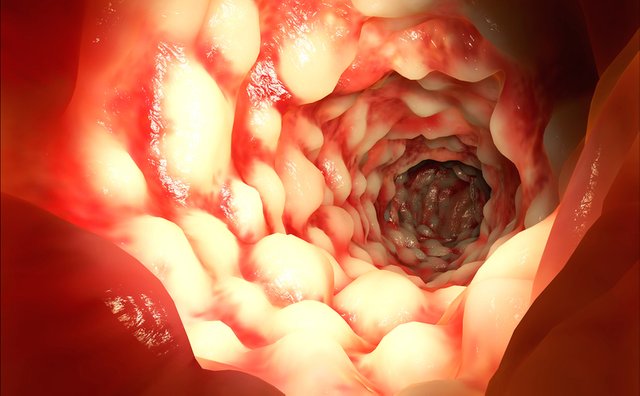A picture depicting Crohn’s disease and its debilitating effects has won the top science Wellcome Image Awards for 2017. This system was set up twenty years ago to provide awards to the world’s most exceptional science images.
As science and technology has developed with time, new and exciting types of images are included for the science Wellcome awards. The first award of 2017 was won by Spooky Pooka for his artwork Stickman – The Vicissitudes of Crohn’s.

Spooky Pooka is a professional illustrator and artist. He makes 3D images using the latest CGI (computer-generated imagery) technology. He tries to include the ethos of the pre-digital Dadaist tradition in his CGI work.
Spooky Pooka made the skeleton with sticks instead of bones which shows the transformative nature of Crohn’s disease. This illustration depicts weight loss, a flare up and fragility. Spooky Pooka suffers Crohn’s disease, which becomes due to an inflammation of the lining of the digestive tract.
What is Crohn’s disease?
Crohn’s disease is also known as inflammatory bowel disease (IBD). This disease may continue whole life due to lack of proper treatment. Parts of digestive system get inflamed, which can lead severe diarrhea, fatigue, abdominal pain malnutrition and weight loss. Crohn’s disease normally occurs in the first part of the large intestine and the last part of the small intestine, but it can happen anywhere in the long digestive system extending from the mouth to the anus.
Crohn’s disease often infiltrates the layers of affected tissue and goes inner part of the digestive system. It can be so painful and debilitating disease, and sometimes it may create life-threatening issue for the patients.
Diagnosing Crohn’s Disease
Doctors may conduct many tests to diagnose Crohn disease as there isn’t any one test that can reveal whether you have Crohn disease or not. It can have many possible symptoms that are found during other health problems. So, it needs combination of exams like lab tests, and imaging studies to be diagnosed.

Diagnosis Crohn’s disease with Physical Exam and History
Doctors will first record the information about your health history and conduct a physical test. Outputs may need further tests are to be done:
- Fever
- Bloody Diarrhea
- Family history of Crohn’s disease
- Pain in the abdomen
Diagnosis Crohn’s disease with Lab Tests
Further lab tests may be required in order to find any problems that may have a relation to Crohn’s disease. These lab tests reveal the sign of inflammation, infection, any kind of internal bleeding and low levels of iron, minerals or protein. The possible lab tests are:
- Blood sedimentation rates
- Blood protein levels
- Red blood cell counts
- Body mineral levels
- White blood cell counts
- Stool samples to check for blood or infectious microbes
Diagnosis Crohn’s disease with Imaging Studies and Endoscopy
Crohn’s disease may emerge anywhere in the digestive system, from the mouth to the anus. The severity and location of Crohn’s disease can be revealed by X-rays and other images. The following studies may be required:
- CT scans
- Barium X-rays and other X-rays
- Video capsule endoscopy
- Colonoscopy or sigmoidoscopy

CT Scans
CT Scans using computer-aided X-ray technique can reveal more detailed and distinct images of the abdomen and pelvis than the images that are produced by traditional X-rays. It can easily detect abscesses that might not be caught by other X-rays.
Barium X-rays and Other X-rays
A barium X-ray plays crucial role in order to find any problems lie in parts of small intestine, which is very difficult to be viewed by other technique. It can reveal the severity and location of Crohn’s disease.
Barium solution is given through mouth or rectum. When the solution is provided through mouth, it is called an Upper GI series. And when it is taken through the rectum, it is called a barium enema. The barium solution appears white on X-ray plate, while moving through the intestines. This facilitates your doctor to reveal the problem areas that include ulcers, narrowed areas of the intestine, abnormal connections between organs, called fistulae, or other kind of problems.
Other X-rays or imaging studies may be required to reveal exactly how much of your digestive system is impacted by Crohn’s disease, if barium X-rays find any symbol of disease.
Video Capsule Endoscopy
Video capsule endoscopy is done by swallowing a small capsule or pill that has a mini video camera to capture the image while traveling through the intestine. It sends the captured images of the lining of the digestive tract to a receiver that you put on a belt around your waist. The images are then downloaded at a computer to reveal detailed information about previous and mild problems associated with Crohn’s disease.
Even though video endoscopy can reveal valuable information, it should be avoided for the following reasons:
- In case of an obstruction in the small intestine, video capsule endoscopy should be avoided since the capsule could get stuck at the obstruction place to make the condition worse.
- If any part of the small intestine gets narrowed due to Crohn’s disease, previous radiation therapy, or previous surgery, the capsule could get stuck there.
- According to some doctors, the wireless transmission sent from the capsule could impact on implanted cardiac pacemakers or defibrillators.
Colonoscopy or Sigmoidoscopy
Colonoscopy and sigmoidoscopy provide direct view of the inner part of the large intestine. These techniques can be used to gather the most accurate information about small ulcers, inflammation, and the severity of inflammation. Colonoscopy is the kind of tool which can better diagnose Crohn’s disease than other techniques.

During these processes, a flexible viewing tube is entered through the anus which further drives to the large intestine. An image of the inner part of the intestine can be viewed on a video monitor. A colonoscopy can reveal the images of all of the large intestine including the end part of the small intestine, which often gets affected by Crohn’s disease while a sigmoidoscopy can discover the problem lies at the lowest part of the large intestine. In either case, the symbol of inflammation, ulcers, or bleeding can be detected clearly and the small samples of tissue can be taken to test under a microscope, called a biopsy. The test will reveal whether the symbol of Crohn’s disease is found on the tissue or not.
Treatment of Crohn’s disease
However it is said that there is no cure for Crohn’s disease, there are some drugs that may relieve the condition. Treatment involves the following goals:
- To reduce inflammation of the lining of the digestive tract
- To ease symptoms of diarrhea, pain, and bleeding
- To provide sufficient nutrition
Crohn’s disease could be treated by drugs, supplements that have sufficient nutrition, surgery, or a combination of these therapies may be required to relieve the condition. Doctors provide the treatment depending on the location of disease, its severity, the complications that are associated with the disease, and the way the patient has reacted to the past treatment when symptoms reappeared. In order to know about further medications of Crohn’s disease, you must consult your local doctor.
Thank you very much for this article. I have a friend suffering from this disease and I really hope that science can make progress with regards to finding a cure or at least some further kind of treatment for him.
Downvoting a post can decrease pending rewards and make it less visible. Common reasons:
Submit
Hope so.
Downvoting a post can decrease pending rewards and make it less visible. Common reasons:
Submit
Amazing picture, excactly how it feels sometimes. I remember reading somewhere that the creator of the chestburster in Alien had Crohn's as well. So at least some great art derives from this awful disease :-D
Downvoting a post can decrease pending rewards and make it less visible. Common reasons:
Submit